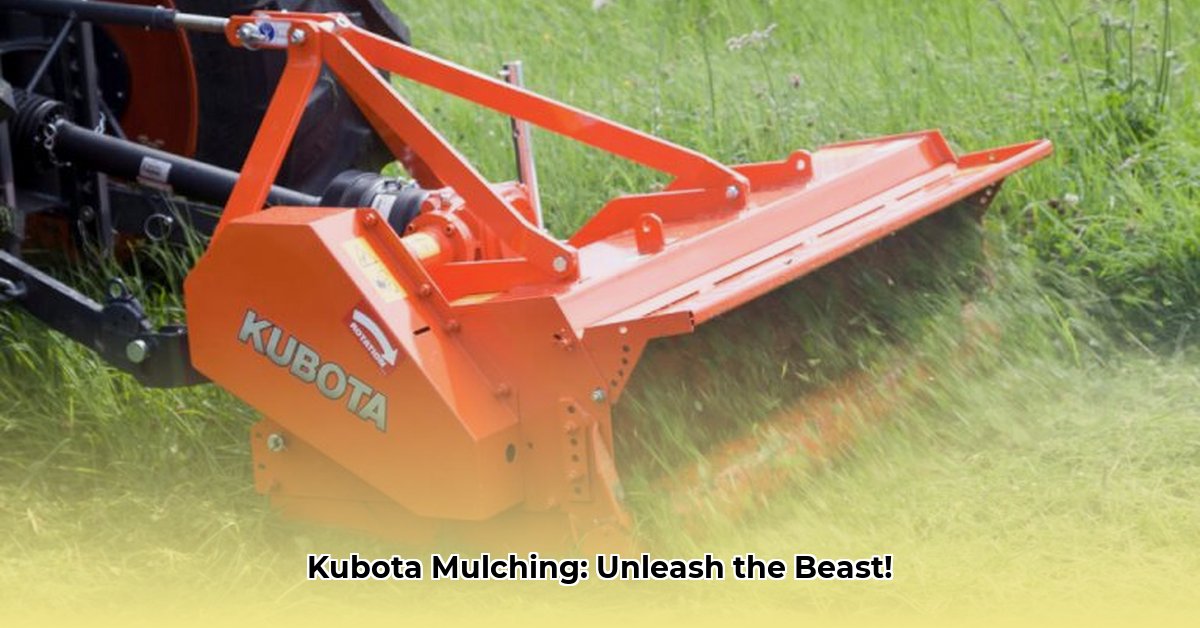
Mulcher for Kubota Tractor: Boosting Your Farm's Efficiency with the Fecon PTO Bull Hog
Choosing the right equipment significantly impacts farm efficiency and sustainability. The Fecon PTO Bull Hog mulcher, designed for Kubota tractors, offers a powerful solution for various land management tasks. This article explores its benefits, applications, and considerations for optimal use. For more information on forestry mulchers, check out this helpful guide.
Finding the Right Mulcher for Your Kubota
Before selecting a Fecon Bull Hog model, assess your specific needs. What land management tasks will it perform? Clearing land for crops? Pasture revitalization? Roadside vegetation maintenance? Your Kubota tractor's horsepower rating is crucial; Fecon offers various sizes to ensure optimal safety and performance. Mismatching can lead to damage or inefficiency. Choosing the correct size is critical for both safety and productivity.
The Fecon PTO Bull Hog: A Closer Look
The Fecon PTO Bull Hog is a precision-built mulching attachment known for its reliability. Its lightweight design reduces strain on your tractor, minimizing wear and tear. Replaceable shear bars lower long-term costs. The consistent mulch size improves soil health and nutrient distribution, promoting better plant growth. Imagine the benefits of finely ground material readily integrating into the soil, compared to large chunks that hinder growth.
Sustainable Farming with the Bull Hog
The Bull Hog contributes significantly to sustainable farming. Efficient clearing improves sunlight penetration, leading to healthier crops and higher yields. It's like giving your crops a much-needed boost! Pasture reclamation is another key application, quickly clearing unwanted brush and weeds. Roadside maintenance becomes faster and easier, reducing labor costs and improving safety. Wouldn't you agree that this leads to significant time and cost savings?
Getting the Most Out of Your Mulcher
Effective mulcher operation demands planning and understanding. Here's a step-by-step approach to maximize the Bull Hog's potential:
Step 1: Pre-Operation Checklist:
- Assess the terrain. Steep slopes might require adjustments to your approach.
- Thoroughly inspect the area for and remove large debris (rocks, logs) to prevent damage and ensure safety. This is a critical safety step, often overlooked. Failure to do this could lead to severe damage or injury.
- Review the manufacturer's instructions to ensure familiarity with all controls and safety procedures.
Step 2: Operation:
- Always follow manufacturer instructions, maintaining safe speeds and avoiding overloading.
- Regular maintenance (greasing, wear checks, timely repairs) is crucial for performance and safety.
- Monitor equipment sounds; unusual noises indicate potential problems.
Step 3: Post-Operation:
- Thoroughly clean the mulcher after each use. Remove debris to prevent damage or corrosion.
- Store the machine in a safe, dry location to prolong its lifespan and protect it from the elements.
Weighing the Pros and Cons
The Fecon PTO Bull Hog offers significant advantages, but also presents some challenges:
| Pros | Cons |
|---|---|
| Versatile; handles various land management tasks | Requires a sufficiently powerful tractor |
| Fuel-efficient operation | High initial purchase cost |
| Durable build; replaceable parts | May require specialized maintenance or repairs |
| Promotes soil health and sustainable practices | Operator training is essential |
Long-Term Sustainability: Beyond the Machine
The Bull Hog's value extends beyond immediate use. Tracking fuel consumption, maintenance costs, and soil health effects provides valuable data for informed decision-making and justifies the investment. The positive environmental impact is a key benefit in itself. Remember that sustainable farming practices rely heavily on data-driven decision making.
Investing in a Fecon PTO Bull Hog is a long-term commitment to improving farming operations. It's a tool for building a more efficient and sustainable future. Regular monitoring and evaluation maximize long-term benefits. Does this align with your vision for a sustainable and efficient farm?
How to Compare Fecon Bull Hog Mulcher to Competitors
Key Takeaways:
- Forestry mulcher selection hinges on land type, vegetation, and tractor capabilities.
- Consider operational efficiency, environmental impact, and cost-effectiveness.
- Different mulcher types have unique strengths and weaknesses. Sustainable practices emphasize on-site mulch utilization.
- Safety and maintenance are crucial for long-term success.
- Long-term costs include fuel, maintenance, and part replacement.
Understanding Your Needs: The First Step in Comparing Mulchers
Before comparing mulchers, define your needs. What vegetation will you tackle? What's the scale of your operation? What's your budget? Remember to factor in long-term maintenance and fuel costs. This initial assessment is crucial for making an informed decision.
Mulcher Types: A Quick Overview
Three main types exist: deck, disc, and drum. Deck mulchers are ideal for lighter vegetation; disc mulchers handle tougher material; and drum mulchers excel in heavy conditions. Each has trade-offs regarding efficiency, mulch quality, and maintenance.
Comparing Mulchers: Key Performance Indicators
Focus on:
- Hydraulic Requirements: Ensure your tractor meets the mulcher's hydraulic demands.
- Mulch Quality: Consider the desired mulch fineness for optimal soil enrichment.
- Durability and Longevity: Examine build quality and manufacturer reputation.
- Maintenance and Servicing: Consider ease of access to components for repairs.
- Fuel Efficiency: Compare fuel consumption under similar conditions.
Environmental Considerations: Sustainable Land Management
Choose a mulcher with minimal environmental impact, focusing on on-site mulch utilization for soil health and minimizing waste.
Safety First: Operator Training & Equipment Inspection
Prioritize safety. Thorough training and regular inspections are paramount for accident prevention and smooth operation.
Cost Analysis: Weighing Short-Term vs. Long-Term Costs
Calculate the total cost of ownership, including initial price, lifetime, maintenance, fuel, and potential repairs. This provides a clearer picture of long-term value